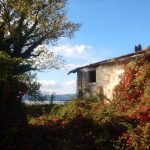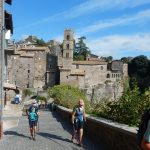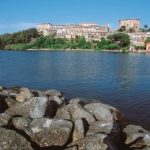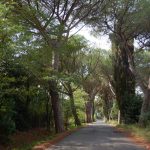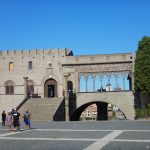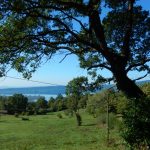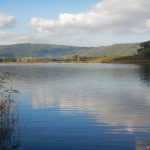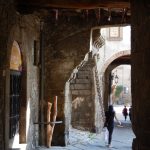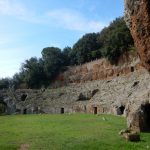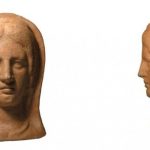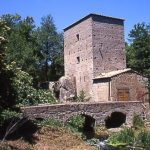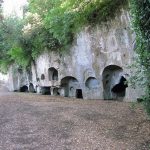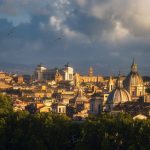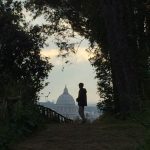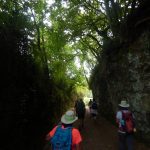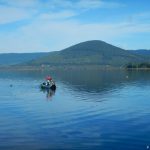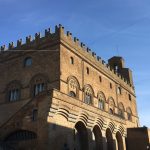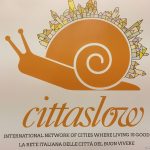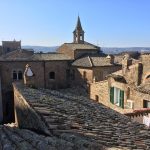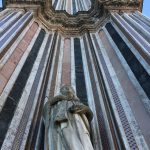Via Francigena: Orvieto to Rome - the last stretch through Lazio - VF7
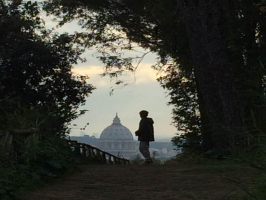 |
|
||||||||||||||||||||||
The final part of the Via Francigena through the Tuscia, the land of the Etruscans
This last part of the Via Francigena is perhaps the area where the intriguing history of the area comes most alive. Here, more than ‘only’ walking over a medieval pilgrim’s route you’ll walk through the heartland of the Etruscans, an ancient civilisation which flourished in this area before the rise of the Roman Empire.
This area, now known as the ‘Tuscia’ area, is an area where the layers of history can all be explored: apart from the Etruscan heritage, of course the Romans left many traces here too, among which one of the best preserves amphitheatres in the ancient city of Sutri. In medieval times a number of fortresses where built in several places, while during the Renaissance Popes and other wealthy families from Rome built their villa’s here, often surrounded by superbly landscaped parks.
In additional to all this, the ‘Tuscia’ is also an area which features a great number of natural wonders, due to its volcanic nature. Your route starts from Lake Bolsena, Italy’s biggest volcanic lake, and one of the stages goes through the volcano of Vico, one of the highlights of the area. A walk along the shores of the volcanic crater lake of Vico is a must! And closer to Rome, perhaps you can refresh yourself at the ‘gelato’ waterfalls!
Of course the closer you get to Rome, the busier it will be. For that reason you will have to chose your route carefully. Some busier parts can possibly be avoided using the public transport. However we have already selected the quietest routes, and even within the city boundaries of Rome you’ll be walking in beautiful forests.
The official route can be divided into 7 (8) stages: from Bolsena (Orvieto) to Montefiascone; from Montefiascone to Viterbo; from Viterbo to Vetralla; from Vetralla to Sutri; from Sutri to Campagnano; from Campagnano to Isola Farnese (or La Storta); from Isola Farnese to Rome. But many other interesting options and detours are possible. Please contact us to know about the actual possibilities.
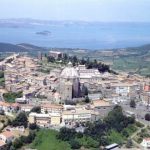 |
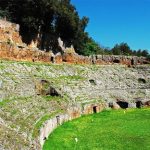 |
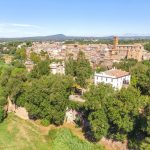 |
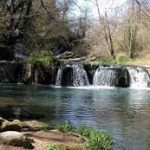 |
This is a moderately challenging tour which is suitable for experienced walkers with a good general physical condition. Through the extensive footpath network of the area, roughly following the traces of the Via Francigena, one of Europe’s most important ‘highways’ in medieval times, you walk from village to village, a full immersion in the ‘Tuscia’, the Etruscan heartland, just north of Rome.
Optional Extra Day(s)
Although not on the ‘official’ route of the Via Francigena – but a great place to start your tour – is Orvieto. This stunning hilltop town is located along Italy’s main railway line, halfway Rome and Florence and it is linked to Bolsena by a beautiful historical walking route. It’s of course a must to make a short tour around Orvieto, known for its wonderful Duomo, but apart from that also one of the most interesting cities of central Italy, with some intriguing underground sights, like the stunning Pozzo di San Patrizio! A great walk brings you all around its medieval walls, with gorgeous views on the surrounding countryside (we would almost suggest another extra night here!).
Then walk down from the rock on which Orvieto is located and exit the medieval town gate. Then follow the ancient route through forested hills and past a recently discovered Etruscan necropolis. Most of the route goes along quiet asphalt and gravel roads and occasionally you’ll walk on the Roman pavement. Towards the end of the walk you’ll enjoy great views over the Bolsena Lake, before continuing the descent into Bolsena, where you can settle in your comfortable hotel. In alternative you can take the local bus and dedicate the whole day to some sightseeing and relax after your week walking along the Via Francigena. In alternative you could start walking down to Bolsena from Civita di Bagnoregia, and visit this stunning town in the middle of the surreal ‘calanchi’, the strange rolling hills south of Orvieto.
Hotel*** – Orvieto
Distance: 16,5 km. Approx. 5 h. walking (several alternatives possible)
Day 1
Arrival in Bolsena. Depending on your arrival time, you can go for a short visit to this beautiful old town, dominated by its big castle, or you can go for a relaxed stroll along the banks of the beautiful volcanic lake. Bolsena is known for the miracle of Corpus Domini and it’s worth visiting the churches. In case you also walk the Siena to Bolsena part of the Via Francigena, you arrive here on foot, passing along the castle and through the old medieval town.
Hotel ***/**** – Bolsena
Total walking time: around 1 h. + sightseeing time
Day 2
The first day walk takes you out of Bolsena along the eastern side of the lake. Avoiding the busy Via Cassia, you’ll walk mostly through the hills, full of Etruscan remains and Today’s walk begins uphill, and leads from the lake shore to the old town of Bolsena. Then through the hills you walk above the eastern shore of lake Bolsena all the way to the beautiful small town of Montefiascone. The walk is mostly through rolling hills, through olive groves, forests and orchards, along woodland tracks and on so-called strade bianche (gravel roads). It was here that the ‘Est-Est-Est’ wine was born. Montefiascone is a beautiful town, worth a visit. Its commanding position on a hilltop provides wonderful views of the whole of the Lago di Bolsena below you, including the islands and the surrounding hills.
Hotel ***/**** – Montefiascone
Distance: 17,5 km. Approx. 4,5-5 h. walking + sightseeing time. Ascent & descent: + 400 m./- 150 m.
Day 3
After having paid a visit to the ‘Rocca’ and the gardens of Montefiascone, with a few ‘Belvederes’, from where you can enjoy beautiful views over the lake of Bolsena, you continue your walk in southern direction today. After having left the outskirts of town and avoiding the busy Via Cassia, you’ll walk on minor roads through the rolling hills. For those who want after about 10 km. you will pass the ‘Bagnaccio’ thermal pools where you could relax for a while in the steamy waters. From here it’s less than 2 hours to Viterbo, a nice small town to stroll around and perhaps have a drink on one of the nice squares. Do take the time to visit the Palazzo dei Papi (‘Palace of the Popes’), almost a small city by itself. Here you’ll settle in your centrally located accommodation.
Hotel*** – Viterbo
Distance: 18,5 km. Approx. 4,5-5 h. walking + sightseeing time. Ascent & descent: + 100 m./- 350 m.
Day 4
After an relaxed breakfast you leave Viterbo in southern direction. There are two possible ‘Via Francigena’ routes from here, but we’ll opt for the route which brings you to the beautiful crater lake of Vico. The initial part of this route brings you along the impressive town walls of Viterbo (which you can leave either through the Porta San Pietro or Porta Romana – to prove you are going in the right direction!). After having left the outskirts of Viterbo behind you, you’ll be walking through the pleasant landscape of the Cimini Mountains, mostly through nice forests. After about 3 hours walking from Viterbo, you’ll reach the ridge of the crater of Vico, now a nature reserve. You then have several possibilities to walk down into the crater, to the shores of the lake, before settling in at your nice agriturismo set in the crater. You’ll enjoy a great dinner based on local specialties tonight.
Agriturismo *** – Lago di Vico
Distance: 16,5 km. Approx. 4,5 h. walking + sightseeing time. Ascent & descent: + 500 m./- 300 m.
Day 5
Today’s route brings you to through some of the most interesting cities of this part of Italy, Vitorchiano and Sutri. But first you’ll have to get out of your volcano. The walk starts which a relaxed, almost level section along the lake shore, but then you’ll have to climb up to the crater edge again. On the edge of the crater you’ll find the stunning village of Vitorchiano, which boast one of the best preserved medieval town centres. Follows a short downhill section, which brings you onto the ‘original’ Via Francigena again. The first village you’ll pass is Capranica, where you’ll arrive towards lunchtime. You’ll cross the whole ‘centro storico’, located on a narrow ridge, and then you descend to the Via Cassia again. Of course we’ll avoid as much as possible this busy road: indeed you’ll be walking almost entirely through forests and fields until reaching the town walls of Sutri. If you still have the energy, look around the old town, and do visit the Madonna del Parto chapel, an ancient pagan temple which was turned into a Christian church and features very interesting frescoes, depicting walking pilgrims!
Hotel *** – Sutri
Distance: 20 km. Approx. 5 h. walking + sightseeing time. Ascent & descent: + 150 m./- 400 m.
Day 6
Today is a long walk, but mostly along easy, quiet roads. At the exit of the town of Sutri, do not miss the big amphitheatre, one of the best preserved in Italy. You then continue in southern direction, through a landscape full of evidence of the glorious 2500 years of history: Etruscan heritage, Roman artefacts and Renaissance villa’s. The first parts goes mainly through rolling hills, but with a downhill bias. Halfway the afternoon you’ll pass the Monte Gelato waterfalls. Then you continue through the regional park of Veio, until you reach, with a last steep climb, the village of Camapagnano Romano, where you’ll stay for the night. Do make a stroll through the Venturi Park, where you can rest under a three-hundred year old yew tree, locally known as the ‘Tree of Death’.
Hotel *** – Campagnano Romano
Distance: 25 km. Approx. 6-6,5 h. walking. Ascent & descent: +/- 250 m.
N.B. This stage can be divided into two sections, and included a hike through the very interesting regional park of the Treja Valley.
Day 7
Also today a pretty long walk awaits you. Most of today’s route will be within the boundaries of the regional park of Veio. The first part of the route carries through pleasant woodland and gives you the possibility to visit the beautiful Valle del Sorbo with its sanctuary of the Madonna del Sorbo. A bit further the area becomes more densely populated and you’ll pass the nice medieval town centre of Formello. Towards the end of the afternoon you’ll reach the most interesting part of the archaeological area of Veio, where you have several possibilities to make longer or shorter loops to visit the area. Again you’ll end your day with a last steep climb, this time up to the nice village of little village of Isola Farnese, located on a ridge overlooking the Veio Valley. It is dominated by its Castello Farnese, from where you can enjoy great views over the surrounding woods and valleys.
Hotel *** – Isola Farnese
Distance: 21,5 km. Approx. 5,5 h. walking. Ascent & descent: + 250 m./- 650 m.
Day 8
A last stretch of the Via Francigena will bring you to the final destination of this journey. Tonight you’ll celebrate your arrival in Rome! Of course, the closer you’ll get to the centre of Rome, the more urbanised the area will be. You will however be surprised by the amount of nature you will come across today. The route we have chosen will bring you through a number of natural areas which literally penetrate into the heart of Rome. First you’ll pass the strange wilderness of the Insugherata Forest and then you’ll walk through the nature reserve of Monte Mario, Rome’s own mountain. From the ‘Belvedere’ of Monte Mario you will have the first views on the dome of Saint Peter’s! From here you’ll walk down to the river Tevere, which flows all across the city. Following the nice walkway/cycling path along the river, you’ll soon enter the heart of town. You’ll walk past the Castle Sant’Angelo, and then you will be face to-face with the St. Peter’s. The monumental Via della Conciliazione will bring you to the great square, where thousands of pilgrims have gathered over the centuries. Have your picture taken, buy a postcard from Vatican City and then take your time to relax – and enjoy the Eternal City!
Hotel ***/**** – Roma
Distance: 25 km. Approx. 6-6,5 h. walking. Ascent & descent: + 200 m./- 300 m.
Day 9
The tour ends after breakfast in Rome.
ACCOMMODATION & MEALS
All nights are spent in beautiful, characteristic family-run hotels (generally 2/3-star; 4/5-star on request) and beautiful agriturismos. All rooms have en-suite facilities.
On all nights you will be free to make your own dinner arrangements. You can choose from the wide choice of restaurants in the area. Your accommodation holder can give you good tips.
No picnic lunches are included in the tour price, but these can be prepared for you by the accommodation holders, or materials for picnics can be purchased in the villages where you’ll be staying. On some occasions you have the option to have your lunch in a restaurant along the way.
UPGRADE/CHANGES IN ACCOMMODATION
It is possible to upgrade this tour, staying in more luxurious 4-star hotels (where available).
LEVEL OF DIFFICULTY
Moderate (3): Mostly moderately easy walks, with some long stages, involving some steep uphill walking, sometimes on paths with rough surfaces. On some days extensions or shortcuts are possible.
Fitness: High standard of fitness is necessary: you should be able to walk for up to 7 hours a day in the hot sun on dusty or stony tracks.
N.B. During summer the difficulty of this tour definitely increases due to the heat. We therefore advise against booking this tour during the period between about 14th July and 20th August.
FOOTPATHS & WAYMARKING
Footpaths: Most paths are relatively well maintained; you’ll follow most of the time the official route of the Via Francigena, well maintained. A large part of the route goes along so-called strade bianche (unsurfaced roads), easy to follow and very unlikely to get overgrown (we continuously check our routes – please help us by providing your feedback on the quality of the paths).
Waymarking: A large part of the route is waymarked with the signage of the ‘Via Francigena’, but on some occasions we have found more interesting routes than those actually waymarked; therefore you should follow the route descriptions provided together with the maps. With these you will always be able to find your route.
INCLUSIONS
- 8 nights accommodation – BB
- 1 night in Hotel**** in Bolsena
- 1 night in Hotel*** in Montefiascone
- 1 night in Hotel*** in Viterbo
- 1 night in Agriturismo in Caprarola
- 1 night in B&B in Sutri
- 1 nights in Hotel*** in Campagnano Romano
- 1 night in Hotel** in Isola Farnese
- 1 night in Hotel*** in Rome
- Luggage transfer (a discount will be applied for those carrying their own luggage)
- Extensive route notes, with description of the route & tourist information
- Maps at 1 : 25.000 scale or better
- GPS tracks for each walk
- Pilgrim Passport
- 24/7 assistance
NOT INCLUDED
- Departure taxes & Visas
- Travel Insurance
- Tourist tax
- Drinks and meals not mentioned in the itinerary
- Optional additional tours or activities
- Tips
- Items of personal nature
ARRIVAL & DEPARTURE
Arrival: The tour starts in BOLSENA, linked by a frequent bus service to ORVIETO, which can easily be reached by train from Florence or Rome.
Departure: The tour ends after breakfast in ROMA – the Eternal City. A frequent train service can bring you to the nearby international airport. There are frequent trains to all other cities in Italy.
| Trip season | Tour price |
Single suppl. |
Solo traveller |
|||
|---|---|---|---|---|---|---|
| 01 November 2024 - 14 March 2025 | - - - | - - - | - - - |
|
CONTACT US | |
| 15 March - 30 June 2025 | € 920 | € 280 | € 170 | RESERVE YOUR PLACE | ||
| 01 July - 31 July 2025 | € 950 | € 290 | € 170 | RESERVE YOUR PLACE | ||
| 01 August - 17 August 2025 | - - - | - - - | - - - | |||
| 18 August - 31 August 2025 | € 950 | € 290 | € 170 | RESERVE YOUR PLACE | ||
| 01 September - 31 October 2025 | € 920 | € 280 | € 170 | RESERVE YOUR PLACE | ||
N.B. Luggage transport from hotel to hotel is included – a discount applies for those carrying their own luggage (75 euro per person – on request).
| You can book this tour with a minimum of 1 person. | |
| There are a very limited number of available places on these dates. Immediate booking is recommended. | |
| Availability and prices on request. |
- Prices are per person and based on the season within which the first night of the tour falls.
- Prices are based on 2 people sharing double or twin accommodation. Single rooms (double rooms – single) are available on most trips however the supplements listed apply.
- If you are travelling alone then on some trips (which include taxi transfers) a ‘Solo Traveller Supplement’ will be applied instead of the normal single supplement.
- Prices are expressed in Euro’s. There will never be a currency surcharge.
- Actual exchange rates: GB £ - US $ - CAN $ - CHF - DKK - SEK - NOK - Other currencies.
It is possible to include some extra nights in your tour, in any of the accommodations ‘en route’. For those who have never been to Rome an extra day here is strongly recommended.
At the beginning of the tour there is the opportunity to stay an extra night in beautiful Orvieto, which can easily be reached by train, and from where a beautiful walkway leads down to Lake Bolsena. Details and prices on request.
Halfway the tour the tour can be extended with an extra ‘loop’ through the area of the Treja, a stunning regional park scattered with many Roman and Etruscan vestiges.
Longer and shorter versions, as well as guided versions, of this tour are also available. Prices on request.
From Rome to the Holy Land – walking through the authentic southern Italy
Now that you have arrived in Rome, the Holy City, the place where most medieval pilgrims were heading for, and have enjoyed your ‘pilgramage’, perhaps you look for more!
So why don’t you continue in southern direction? Part of the pilgrims, during medieval times (and also later) travelled on to the ‘Holy Land’. They continued along the so-called ‘Vie Francigene’ of southern Italy, a series of routes from Rome to south-eastern Italy, mostly towards the port of Brindisi, where they could embark for the Holy Land.
The Via Francigena therefore does not end in Rome!
Of course the pilgrims used mostly the roads which were already there: the Roman roads such as the Via Appia, (which can still be walked), the Via Popilia and the Via Traiana, which follow the most obvious passes and the most ‘logical’ routes from Rome to Brindisi and which were in place already since a 1000 years at the time of the pilgrimages.



















